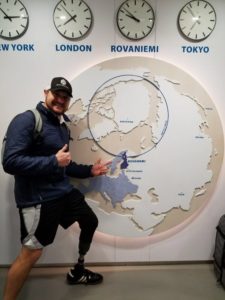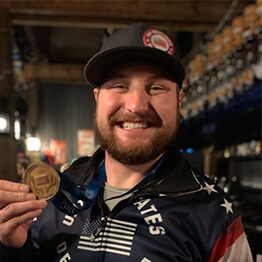Joe’s Story
Joe's Story
Joe Pleban had developed a rare and painful joint disease called pigmented villonodular synovitis (PVNS) that caused tumors to invade his ankle. A lifelong athlete, Joe tried numerous surgeries and treatments in an attempt to return to his active lifestyle, but with no success.
“I started to lose these huge chunks of my life with each sport that I lost the ability to play,” said Joe. When he was no longer able to participate in his beloved snowboarding sport, he despaired. Finally, his only option was either an ankle fusion, which would limit his mobility, or amputation. Joe chose amputation in the hope of continuing his sporting lifestyle with the use of a prosthetic.
Joe famously tattooed “Please cut here” on his left ankle a month before his amputation surgery and took his left foot on a bucket list of adventures.
Unfortunately, Joe’s amputation left him with nerve and phantom limb pain. The active life he had envisioned for himself could not be realized because the pain prevented him from using his prosthetic.
“I could describe [the phantom limb pain] with a great deal of precision,” said Joe. “For example, it felt like someone was taking my second biggest toe and pulling it backwards as far as they could. Or someone was taking my last two toes and curling and crushing them. Or someone was sticking a needle through my ankle. And then there was just a constant pain along with twinges of sharp pain.”
A search for solutions
To manage his pain, Joe was prescribed anti-inflammatories, opioids and nerve pain medications. Joe said the anti-inflammatories “didn’t put a dent” in the pain. The other medications were not ideal for long-term use.
Joe tried other therapies, including something called “mirror therapy,” which took the pain away, but only for a matter of minutes. Other interventions included an additional surgery to remove painful neuromas, and another to fuse sensory nerves together. However, neither surgery was effective in relieving Joe’s phantom limb pain long term.
“I had made this decision to amputate my foot so I could live an active lifestyle,” said Joe, “but I found myself stuck in this terrible limbo of not being active – and also missing a foot.” Without his prosthetic, even simple tasks, such as going to the bathroom, became a major production.
About a year and a half after his amputation, Joe learned through another physician about a study being done at Northwestern University. The Northwestern study was evaluating targeted muscle reinnervation (TMR) surgery as a treatment for post-amputation pain.
At that point, Joe said he was willing to try anything. He applied and was accepted into the study. Joe, along with his wife, mother and new puppy, made the 700-mile road trip from their home in Virginia to Chicago, where he had the TMR surgery.
The road to recovery
“I admit that initially my wife and I were nervous because I was still having phantom nerve pain after the surgery,” said Joe. “About 3 months out, though, my pain began to lessen. At 5 or 6 months out, there was a significant difference.”
Joe describes his recovery as a gradual process toward pain relief and return to an active lifestyle.
“It wasn’t like a light switch. But I became more active. I could wear my prosthetic longer without hurting. And I started running again. I remember getting back from running a 5K loop in my prosthetic, and my wife said, ‘You know, you haven’t mentioned phantom pain in a while.’ That’s when it clicked that the surgery had been successful. Since then, the pain hasn’t come back.”
Joe urges TMR patients to remain optimistic as they journey through recovery. “Someone said to me, recovery always looks so much longer at the beginning than when you look back,” [The time it takes] is such a small price to pay for the lifetime of freedom that comes afterward,”
Today, Joe has returned to snowboarding as a member of the US Para Snowboard Team and also competes in World Para Snowboarding, which has allowed him to travel the world.
“Nerve pain shouldn’t be what’s holding you back if you have a disability,” said Joe. “If nerve pain is holding you back, TMR needs to be an option to explore. Every patient should have the option to consider it.”
